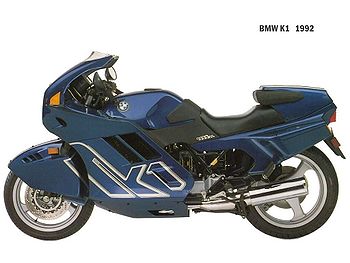BMW K1
The introduction of this new model. with its totally innovative appearance, caused a sensation, particularly since it came from BMW, normally so careful to respect its own design traditions, The astounding K1 under development since 1983 and unveiled in 1988 -was the result of BMW's constant research program,
| Manufacturer | BMW |
|---|---|
| Production | 90-94 |
| Sparkplug | DR8EA '90-94 |
| Battery | 53030 '90-94 |
| Front Tire | 120/70-17 '90-94 |
| Rear Tire | 160/60-18 '90-94 |
| Manuals | Service Manual |
| Tech Specs · Brochures · Reviews · Ads · Videos | |
Designed in the Wind Tunnel
The classical styling of their models often incorporated carefully studied aerodynamics's, but in the extreme case of the K1, BMW; chose to ignore both current fashion and the conservative taste of their traditional clients, BMW would be guided by the functional standards dictated by wind-tunnel studies. The K1 was the final descendant in a long line that went back to Ernest Henne's streamlined record-breakers of the Thirties (174 mph in 1937) through the R100RS of 1976.
Aerodynamically Efficient
Exhibiting a sculpted look, the K1 sported a streamlined front tire and, in wind-tunnel tests, recorded a record low drag coefficient of 0.34, The maximum speed benefited considerably: the K1 could achieve almost 150 mph on just 100 hp. A pure sporting machine, the K1 was more of a grand tourer than the replica racers the Japanese loved.It could comfortably carry a passenger, had built-in luggage lockers, and even offered 250 cubic inch baggage compartments as an option.
- Spark Plug: NGK DR8EA
